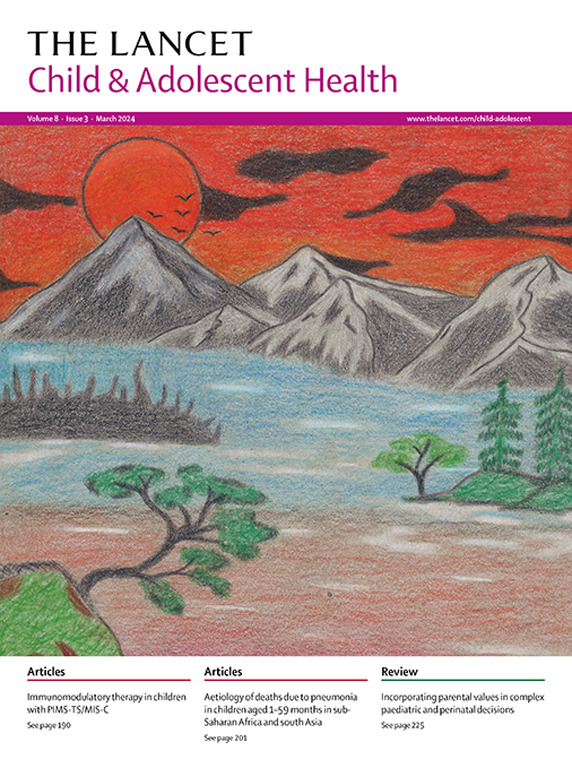International benchmarking of stage at diagnosis for six childhood solid tumours (the BENCHISTA project): a population-based, retrospective cohort study
IF 19.9
1区 医学
Q1 PEDIATRICS
引用次数: 0
Abstract
Background
International variation in childhood cancer survival might be explained by differences in stage at diagnosis, among other factors. As part of the BENCHISTA project, we aimed to assess geographical variation in tumour stage at diagnosis through the application, by population-based cancer registries working with clinicians, of the international consensus Toronto Childhood Cancer Stage Guidelines.
Methods
This population-based, retrospective cohort study involved 67 cancer registries from 23 European countries, Australia, Brazil, Japan, and Canada. Participating cancer registries applied the Toronto Guidelines to stage all incident cases of six childhood solid tumours—neuroblastoma, medulloblastoma, and Wilms tumour (age 0–14 years) and Ewing sarcoma, rhabdomyosarcoma, and osteosarcoma (age ≤19 years)—diagnosed between Jan 1, 2014, and Dec 31, 2017. Eligible cancer registries were those able to assign stage according to the Toronto Guidelines; information on the staging investigations conducted was collected where available. European countries were grouped by geographical area and non-European countries were considered individually. We used χ2 tests to compare stage distribution across these geographical areas and multivariable logistic models to estimate odds ratios (ORs) for metastatic stage at diagnosis, using central Europe (Austria, Belgium, France, Germany, the Netherlands, and Switzerland) as the comparison. Sensitivity analyses were conducted to overcome potential bias from non-random missing stage information for some geographical areas and cancer types.
Findings
Data from 10 937 patients with cancer (6031 [55·1%] male and 4906 [44·9%] female) were analysed. Tumour staging was complete for 93·1% (10 180 of 10 937) of patients, ranging from 88·7% (1347 of 1518 patients) with medulloblastoma to 96·5% (1083 of 1122 patients) with Ewing sarcoma. Stage distribution differed statistically by geographical area for neuroblastoma, Wilms tumour, osteosarcoma, and rhabdomyosarcoma, but not for Ewing sarcoma or medulloblastoma. After excluding patients with missing stage information and, for the sarcomas, patients aged 18–19 years, the proportions of patients with metastases detected at diagnosis were 50·3% with neuroblastoma (1435 of 2852 patients; including 1159 [40·6%] stage M and 276 [9·7%] stage MS), 35·1% with medulloblastoma (473 of 1347 patients; stages M1–M4), 32·6% with Ewing sarcoma (335 of 1028 patients), 29·0% with rhabdomyosarcoma (368 of 1267 patients), 25·5% with osteosarcoma (345 of 1353 patients), and 18·2% with Wilms tumour (384 of 2114 patients). After adjusting by age group, significant differences in the proportions of patients with metastases detected at diagnosis were found between geographical areas for neuroblastoma, Wilms tumour, osteosarcoma, and rhabdomyosarcoma.
Interpretation
Assessed at a population level, the stage at diagnosis shows significant variation between geographical areas for several childhood tumours. This finding highlights the need for earlier diagnosis and standardisation of investigations for distant metastases. To enable ongoing comparisons, further cooperation efforts are required between cancer registries and clinicians regarding the sustainable and standardised use of the Toronto Guidelines at diagnosis.
Funding
Children with Cancer UK and Associazione Italiana per la Ricerca sul Cancro.
求助全文
约1分钟内获得全文
求助全文
来源期刊

Lancet Child & Adolescent Health
Psychology-Developmental and Educational Psychology
CiteScore
40.90
自引率
0.80%
发文量
381
期刊介绍:
The Lancet Child & Adolescent Health, an independent journal with a global perspective and strong clinical focus, presents influential original research, authoritative reviews, and insightful opinion pieces to promote the health of children from fetal development through young adulthood.
This journal invite submissions that will directly impact clinical practice or child health across the disciplines of general paediatrics, adolescent medicine, or child development, and across all paediatric subspecialties including (but not limited to) allergy and immunology, cardiology, critical care, endocrinology, fetal and neonatal medicine, gastroenterology, haematology, hepatology and nutrition, infectious diseases, neurology, oncology, psychiatry, respiratory medicine, and surgery.
Content includes articles, reviews, viewpoints, clinical pictures, comments, and correspondence, along with series and commissions aimed at driving positive change in clinical practice and health policy in child and adolescent health.
 求助内容:
求助内容: 应助结果提醒方式:
应助结果提醒方式:


